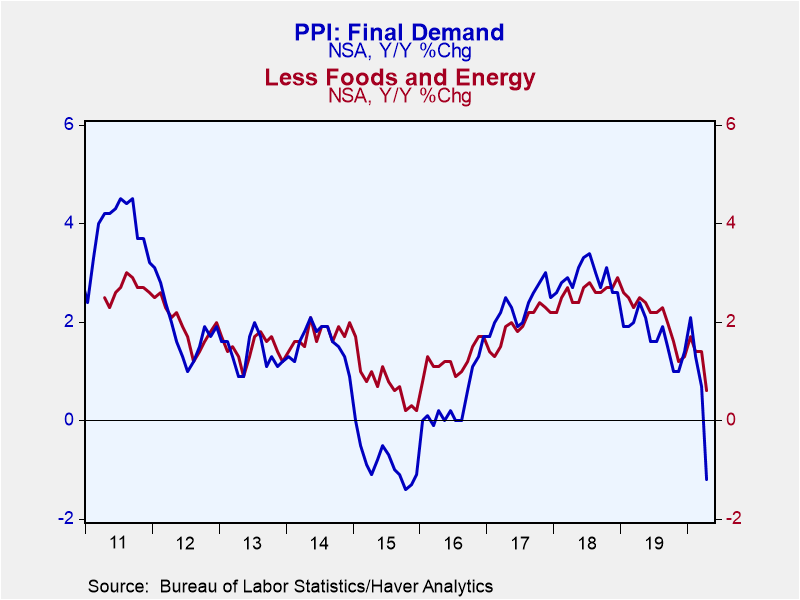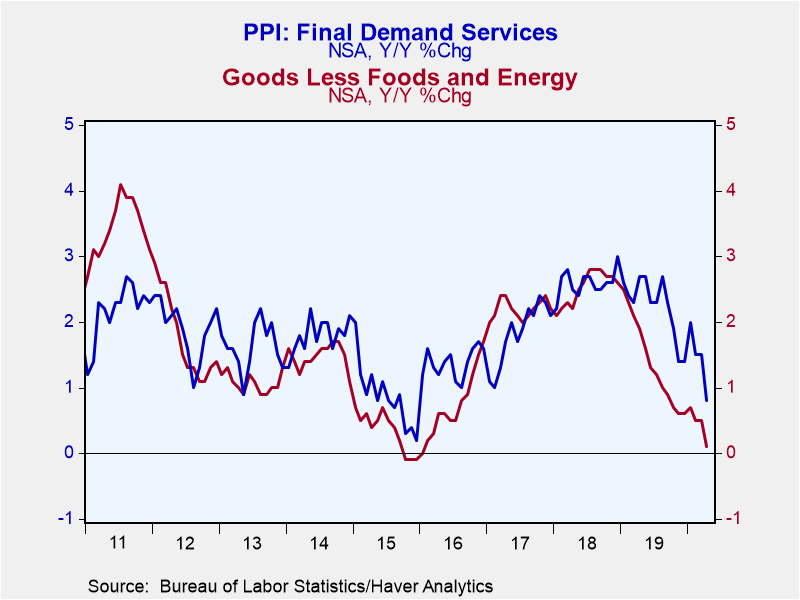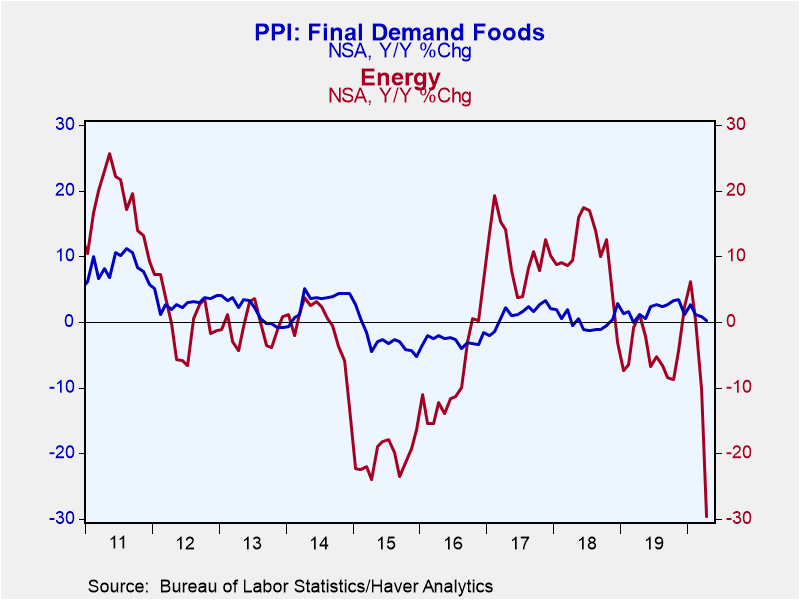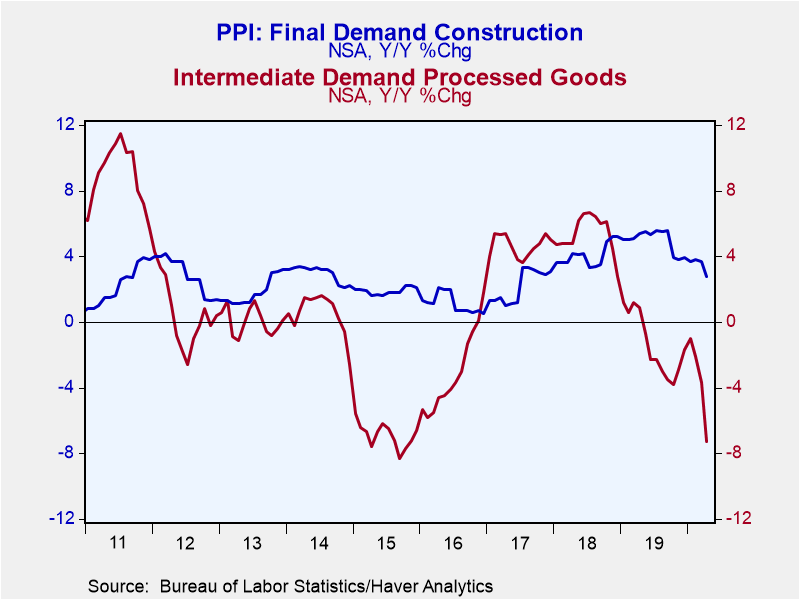 Global| May 13 2020
Global| May 13 2020U.S. Producer Prices Weaken as Energy Prices Decline
by:Tom Moeller
|in:Economy in Brief
Summary
• Lower oil prices drag the PPI lower. • Prices for other goods weaken. • Services prices decline. Industrial sector pricing power remains weak with the downturn in economic activity. The Producer Price Index for final demand declined [...]
• Lower oil prices drag the PPI lower.
• Prices for other goods weaken.
• Services prices decline.
Industrial sector pricing power remains weak with the downturn in economic activity. The Producer Price Index for final demand declined 1.3% (-1.2% y/y) during April following a 0.2% easing in March. A 0.5% decline had been expected in the Action Economics Forecast Survey. Underlying pricing pressure also remained weak. Producer prices excluding food & energy eased 0.3% (+0.6% y/y) following a 0.2% gain. An unchanged reading had been expected. The PPI excluding food, beverages and trade services, another measure of underlying price inflation, fell 0.9% (-0.3% y/y) after modest easing during the prior two months.
Lower energy prices were the largest catalyst for last month's PPI decline, falling 19.0% (-29.6% y/y) after being down in each of the prior three months. Gasoline prices collapsed 56.6% (-67.0% y/y) while home heating oil prices were off 35.6% (-47.3% y/y). Natural gas prices eased 0.5% (-2.2% y/y) after holding steady for two months. Working upward by 0.2% (-0.1% y/y) was the cost of electric power.
Food prices fell 0.5% (+0.3% y/y) after holding steady in March. A 12.6% rise (0.8% y/y) in beef & veal prices followed four consecutive months of decline. This strength was offset by a 4.4% drop (-2.4% y/y) in dairy product prices. Fruit & melon prices declined 10.5% (NSA, -7.3% y/y) and vegetable costs were off 3.4% (-7.5% y/y). Dairy product pries fell 4.4% (-2.4% y/y) but egg prices jumped roughly one-third and were 111.9% higher y/y.
Final demand goods prices less food & energy were off 0.4% in April (+0.1% y/y) after a 0.2% rise. The cost of finished consumer goods less food & energy held steady (1.1% y/y) for the third month in the last four. Core nondurable goods prices improved 0.3% (1.7% y/y) after rising 0.2% in each of the prior two months. Women's apparel prices rose 1.4% (0.9% y/y) but men's clothing costs held steady (1.1% y/y). Durable product prices eased 0.3% (-0.1% y/y). This reflected a 0.4% decline (-1.0% y/y) in passenger car prices and a 0.6% rise, both m/m and y/y, in household appliance costs. Private capital equipment prices fell 0.2% (+1.0% y/y) following a 0.3% gain in March.
Services prices for final demand slipped 0.2% (+0.8% y/y) after rising 0.2% in March. Trade services prices strengthened 1.6% (3.4% y/y), as the cost of trade of finished goods surged 1.9% (3.8% y/y). A 3.5% decline (-6.3% y/y) in transportation & warehousing prices offset the rise. Excluding these costs, prices declined 0.9% (+0.3% y/y).
The cost of construction rose 0.5% (2.8% y/y) following two straight months of 0.1% increase.
Intermediate product prices fell 3.7% (-7.3% y/y), the fourth consecutive month of decline.
The PPI data can be found in Haver's USECON database. Further detail can be found in PPI and PPIR. The expectations figures are available in the AS1REPNA database.
Current Economic Issues from Chair Jerome H. Powell is available here.
| Producer Price Index (SA, %) | Apr | Mar | Feb | Apr Y/Y | 2019 | 2018 | 2017 |
|---|---|---|---|---|---|---|---|
| Final Demand | -1.3 | -0.2 | -0.6 | -1.2 | 1.7 | 2.9 | 2.3 |
| Excluding Food & Energy | -0.3 | 0.2 | -0.3 | 0.6 | 2.1 | 2.6 | 1.9 |
| Excluding Food, Energy & Trade Services | -0.9 | -0.2 | -0.1 | -0.3 | 2.0 | 2.9 | 2.1 |
| Goods | -3.3 | -1.0 | -0.9 | -5.0 | 0.4 | 3.4 | 3.4 |
| Foods | -0.5 | 0.0 | -1.6 | 0.3 | 1.8 | 0.2 | 1.2 |
| Energy | -19.0 | -6.7 | -3.6 | -29.6 | -4.4 | 10.1 | 10.6 |
| Goods Excluding Food & Energy | -0.4 | 0.2 | -0.1 | 0.1 | 1.4 | 2.5 | 2.2 |
| Services | -0.2 | 0.2 | -0.3 | 0.8 | 2.2 | 2.6 | 1.8 |
| Trade Services | 1.6 | 1.4 | -0.7 | 3.4 | 2.5 | 1.8 | 1.5 |
| Construction | 0.5 | 0.1 | 0.1 | 2.8 | 4.9 | 4.1 | 2.2 |
| Intermediate Demand - Processed Goods | -3.7 | -1.1 | -0.9 | -7.3 | -1.4 | 5.4 | 4.7 |
Tom Moeller
AuthorMore in Author Profile »Prior to joining Haver Analytics in 2000, Mr. Moeller worked as the Economist at Chancellor Capital Management from 1985 to 1999. There, he developed comprehensive economic forecasts and interpreted economic data for equity and fixed income portfolio managers. Also at Chancellor, Mr. Moeller worked as an equity analyst and was responsible for researching and rating companies in the economically sensitive automobile and housing industries for investment in Chancellor’s equity portfolio. Prior to joining Chancellor, Mr. Moeller was an Economist at Citibank from 1979 to 1984. He also analyzed pricing behavior in the metals industry for the Council on Wage and Price Stability in Washington, D.C. In 1999, Mr. Moeller received the award for most accurate forecast from the Forecasters' Club of New York. From 1990 to 1992 he was President of the New York Association for Business Economists. Mr. Moeller earned an M.B.A. in Finance from Fordham University, where he graduated in 1987. He holds a Bachelor of Arts in Economics from George Washington University.










